Posted on July 16th, 2010 in AK Distribution
Just what is the distro top 10? That’s a question that has been asked through the ages. Is it new books? The best books? What the kids are buying these days? Because I am old and cannot learn, I’ve decided to just do what I like (I’m going to make a great senior, eh?!). So this month I’ve decided to make a list of books (in an order that only makes sense to me) that I am surprised are not selling like the hotcakes they are. Isn’t that weird? I might not even do 10 of them. Think of me at 80!!!
—–
 This is an Honour Song: Twenty Years Since the Blockades
This is an Honour Song: Twenty Years Since the Blockades
Kiera L. Ladner and Leanne Simpson (editors)
This week marks the 20th anniversary of the beginning of the “Oka Crisis,” AKA the Mohawk Defense of Kanasetake. Like the US, Canada has a long and shameful history of genocide and treaty violations against First Nation peoples, in this case escalating when the nearby town decided, without consulting the Mohawks, to build a golf course on their sacred lands. You should find out more. You should get this book.
 Revolution and Other Writings: A Political Reader Gustav Landauer
Revolution and Other Writings: A Political Reader Gustav Landauer
translated by Gabriel Kuhn
The first comprehensive collection of Gustav Landauer’s work in English! I think people are buying this book (so it doesn’t need my ramblings), but that’s good. You should buy more!!

.
.
Quick and Easy Vegan Comfort Food
Alicia C. Simpson
Oh, I’m sorry, vegans, do you not like macaroni and cheese? What about french toast? I actually ordered a bunch of these cause I thought the answers to the above questions would both be a resounding yes, and I am surprised that it is not selling very well. I guess I do not know my constituency. So sad. It’s a good book!!!!
 Raider Nation, Volume 1: From the January Rebellions to Lovelle Mixon and Beyond
Raider Nation, Volume 1: From the January Rebellions to Lovelle Mixon and Beyond
Raider Nation Collective (editors)
As those with their ear to the ground or their eyes on their TVs can tell you, Oakland is a mess right now. I’m getting emails from far away friends asking about the riots and what’s at the root, but not from all of you!! (Please don’t email me.) So here, in a handy pamphlet/magazine, is an answer and a place to start.

.
The Tragic Procession: Alexander Berkman and Russian Prisoner Aid
Alexander Berkman et al.
Truth be told, I am part of the group who organized the printing, so I should be quiet, but, says John at Red Emma’s, “The pages of these bulletins, published by anarchist luminaries like Alexander Berkman and Rudolph Rocker, shine a light on the early years of totalitarianism in the Soviet Union and the complete betrayal of the ideals of the Revolution of 1917. Alongside the vital and nearly forgotten testimonies of imprisoned and exiled anarchists, who in many ways were the first victims of the purges, show trials, gulags, and judicial murder that would characterize the worst years of the Soviet state, the bulletins also provide a fascinating glimpse into the composition of a transcontinental network of anarchist prisoner support. Certainly not cheerful reading, but then again, if history was always happy we’d have no use for it!”
 Hopes and Prospects
Hopes and Prospects
Noam Chomsky
Do you know this exists? It’s brand new (ie. not a collection of old essays, and newly released), it’s Noam Chomsky, and it’s on sale (as are all the other books from Haymarket this month)!
.
.
.
Posted on July 15th, 2010 in Current Events, Recommended Reading
Y’all were (unfortunately) treated to some of my reportsback from the USSF a couple of weeks ago, as Suzanne and Jessica and I beat our way through the wilds of Detroit. But I think I failed to mention that, for me, one of the things I was most looking forward to at the Social Forum was the chance to hear the incomparable Grace Lee Boggs speak in person. For those who don’t know, Grace was one of the forces behind the Johnson-Forest Tendency, with autonomist Marxists (and humanists) C.L.R. James and Raya Dunayevskaya. Of course, all things being what they were (i.e., insanely busy between the panels I was speaking on, and the tabling), I didn’t actually get to go to any of Grace’s talks! But John from Red Emma’s managed to sneak off to catch Grace’s conversation with world-systems-analyst Immanuel Wallerstein, and he was kind enough to record it for all of us who weren’t there! So, enjoy.
*******************************
THURSDAY JUNE 24 at the United States Social Forum: A Conversation with Immanuel Wallerstein & Grace Boggs
What time is it on the clock of the world? Grace Lee Boggs and Immanuel Wallerstein draw on more than 50 years of experience exploring questions activists face for {r}evolutionary change in the 21st Century.
Posted on July 14th, 2010 in Anarchist Publishers, Recommended Reading
Like many of you, I’m sure, I spend a lot of time trolling the internet for interesting bits of anarchist and radical history. I’m probably happiest in this obsessive endeavor when I come across archives that house entire (or nearly entire) runs of a single periodical. There are a bunch of them out there…probably a lot more than I’ve discovered so far.
 The best thing about such archives (especially the ones that supply facsimile reprints) is how tangible they make our radical histories—both when reading a single article embedded in its context of a single issue, and when tracking the development and mutations, the new strategies, debates, and concerns of a publication over a period of years.
The best thing about such archives (especially the ones that supply facsimile reprints) is how tangible they make our radical histories—both when reading a single article embedded in its context of a single issue, and when tracking the development and mutations, the new strategies, debates, and concerns of a publication over a period of years.
Hence, my idea for this monthly blog column, Back Issues. The plan is to share some of my favorite finds, providing as much context as I can. Some of that context is available on the archive sites themselves; some I can probably provide; and some I hope to have written by others (historians, archivists, and also by folks involved with the periodical).
I plan to focus on anarchist and (more or less) anarchist-friendly publications, but will also include archives of things that I found important for my own political development…or that I think raise interesting questions for anarchists.
 If you have any ideas, or know of any good online archives, please let me know in the comments box or email me at blog[at]akpress.org. Another function this column might serve is to identify publications that should be digitally archived, and maybe find folks willing to help make it happen (there’s one journal I’ll present in an upcoming column that I will be scanning and uploading myself).
If you have any ideas, or know of any good online archives, please let me know in the comments box or email me at blog[at]akpress.org. Another function this column might serve is to identify publications that should be digitally archived, and maybe find folks willing to help make it happen (there’s one journal I’ll present in an upcoming column that I will be scanning and uploading myself).
Thanks,
charles
—–
 So, for the first installment of Back Issues, I’ve decided to highlight two publications archived at the Brown University Library Center for Digital Initiatives: Radical America and Cultural Correspondence. Both were founded by historian Paul Buhle (the first with his wife Mari Jo Buhle, and the second with Dave Wagner). I’d say that they fall under the “anarchist-friendly” heading. As Buhle said in an interview, Radical America, “at its best, had the CLR James vision of a movement that needed to replace the political State rather than infiltrating it, and a future that reflected what we called ‘self-activity,’ a descendant of Wobbly syndicalism, rather than social democratic or communist bureaucracy.”
So, for the first installment of Back Issues, I’ve decided to highlight two publications archived at the Brown University Library Center for Digital Initiatives: Radical America and Cultural Correspondence. Both were founded by historian Paul Buhle (the first with his wife Mari Jo Buhle, and the second with Dave Wagner). I’d say that they fall under the “anarchist-friendly” heading. As Buhle said in an interview, Radical America, “at its best, had the CLR James vision of a movement that needed to replace the political State rather than infiltrating it, and a future that reflected what we called ‘self-activity,’ a descendant of Wobbly syndicalism, rather than social democratic or communist bureaucracy.”
 They both were important to me as a young critter in the 1970s and 1980s, for the fact that they addressed new and emergent concerns on the left about which the old-school stuff I was reading often had little to say, and for their frequent focus on culture (art, music, poetry, comics…even popular culture), which made “politics” a lot more interesting.
They both were important to me as a young critter in the 1970s and 1980s, for the fact that they addressed new and emergent concerns on the left about which the old-school stuff I was reading often had little to say, and for their frequent focus on culture (art, music, poetry, comics…even popular culture), which made “politics” a lot more interesting.
The great Brown Library site includes plenty of background information on both journals, reproduced below, so read on. And to jump straight to the archives themselves (nice facsimile PDFs), just click on the name of each journal.
—–
RADICAL AMERICA, 1967–1999
Radical America was a product of the campus-based New Left of the late 1960s, specifically the Students for a Democratic Society (SDS), but the magazine long outlived its seedbed. Its trajectory shows something about the effort to place an intellectual stamp on the radical impulses of the late twentieth century.
The SDS-connected Radical Education Project, formed in 1966, encouraged SDS members to start long-distance study groups that would explore topics relevant to the new radicalism. Paul Buhle, then a US history graduate student at the University of Connecticut, started one that he called American Radical History & Political Thought, exchanging letters with a handful of interested SDS members across the country. After a few months he got their cooperation in a mimeographed “journal” called Radical America, which seemingly exists now (2006) only in memory.
Paul and his wife, historian Mari Jo Buhle, took up residence at the University of Wisconsin in the fall of 1967. He recruited several members of the local SDS chapter to work on the fledgling journal and made it into a bimonthly, printed by volunteers in a 5½ x 8½ format on a small printing press owned by the Madison SDS chapter. Single copies sold for 50¢; subs were $3, or $2 for SDS national members. The first year’s issues offered a miscellany of articles and documents having to do with the history of American radicalism. A frequent theme, however, was the very recent history of New Left organizing efforts — commentary by participants, as in Peter Wiley’s article “Hazard, Ky.: Failure and Lessons” (Vol. 2 No. 1) or Richard Rothstein’s “ERAP: Evolution of the Organizers” (Vol. 2 No. 2).
 In mid-1968, Paul Buhle started to take the magazine in a different direction, emphasizing special themes and farming out some issues to groups of radically minded thinkers in other cities. (It was still produced in Madison, and a shifting group of local people helped with the production.). The first issue to mark the new trend was Vol. 2 No. 4 (July-August 1968), most of it devoted to historical and contemporary articles on Black liberation, laced with poetry and chosen mainly by historian George Rawick. Two issues later, the final 1968 issue (Vol. 2 No. 6), had as its theme “Radicalism and Culture,” again with poetry mingled with the articles.
In mid-1968, Paul Buhle started to take the magazine in a different direction, emphasizing special themes and farming out some issues to groups of radically minded thinkers in other cities. (It was still produced in Madison, and a shifting group of local people helped with the production.). The first issue to mark the new trend was Vol. 2 No. 4 (July-August 1968), most of it devoted to historical and contemporary articles on Black liberation, laced with poetry and chosen mainly by historian George Rawick. Two issues later, the final 1968 issue (Vol. 2 No. 6), had as its theme “Radicalism and Culture,” again with poetry mingled with the articles.
Nineteen sixty-nine, corresponding to Vol. 3 of RA, reflected the same trends. The January-February issue (No. 1) took the form of a comic book, edited by the underground cartoonist Gilbert Shelton, by far the all-time biggest seller of all RA issues. Other themes that year included working-class history (No. 2), Louis Althusser (No. 5), and youth culture (No. 6). This was the year that SDS split asunder at its July national convention in Chicago, soon marked in RA by the disappearance (in No. 6) of the special subscription rate for “SDS national members.”
Rather than letting Radical America follow SDS to the grave, Buhle in 1970 committed a remarkable act of will by putting the journal on a nearly monthly basis and switching it almost entirely to special issues. The nine issues of 1970 (Vol. 4) had a range that can be readily seen by a visual tour of the covers: from Surrealism (No. 1) and Women’s Liberation (No. 2) to Radical Historiography (No. 9). Among notable issues in-between were the first US translation of Guy Debord’s Situationist document Society of the Spectacle (No. 5) and a bulky anthology of writings by the Caribbean Marxist C.L.R. James (No. 4).
(more…)
Posted on July 13th, 2010 in AK Distribution, Happenings
Good Morrow!
 Sleep-deprived Macio here with a lovely reportback on Detroit’s 12th annual Allied Media Conference. In case you are sleeping on this empowering collaboration of media, technology and communication in the name of social justice allow me to break down the essentials.
Sleep-deprived Macio here with a lovely reportback on Detroit’s 12th annual Allied Media Conference. In case you are sleeping on this empowering collaboration of media, technology and communication in the name of social justice allow me to break down the essentials.
The Allied Media conference happens in the summer of every year. Its’ mission: to inspire and supply tools for do-it-yourself media as a strategy for social justice organizing. Throughout the AMC over one hundred workshops are conducted in hopes of sparking change through education. Some sample workshops include Build a Mini Radio Transmitter, Radical Comic Book Making, Media Tools for LGBTQ Youth Organizing, How to Create a Multimedia Renewable Energy Demonstration Vehicle, How to Make Mud Stencils, Indigenous Media Organizing to End the Occupation and the list goes on! There are even ‘kid only’ tracks for children under the age of 12.
 Aside from these amazing workshops, AMC organizers implement fun social events for attendees. Some of these include karaoke while bowling, and various musical events with artists like Climbing Poetree, Defiance Ohio, and Tamar-Kali. The Detroit community really opens its arms to this AMC. Local eateries provide discounts, Cass Café hosted an all-night dance party and local community members were in high attendance.
Aside from these amazing workshops, AMC organizers implement fun social events for attendees. Some of these include karaoke while bowling, and various musical events with artists like Climbing Poetree, Defiance Ohio, and Tamar-Kali. The Detroit community really opens its arms to this AMC. Local eateries provide discounts, Cass Café hosted an all-night dance party and local community members were in high attendance.
 The AK Press table was stocked with great titles AK and Distro alike! We had new stuff like Guerrilla USA: The George Jackson Brigade and the Anticapitalist Underground of the 1970s, One Less Car: Bicycling and the Politics of Automobility, Procesos revolucionarios en América Latina, We Are an Image from the Future, and Dispersing Power. And our oldies but goodies like The Coming Insurrection, The Revolution Will Not Be Funded, FBI War on Tupac Shakur and Other Black Leaders, and Come Hell or High Water. Our excellent and varied selection of vegan books was a hit, as always.
The AK Press table was stocked with great titles AK and Distro alike! We had new stuff like Guerrilla USA: The George Jackson Brigade and the Anticapitalist Underground of the 1970s, One Less Car: Bicycling and the Politics of Automobility, Procesos revolucionarios en América Latina, We Are an Image from the Future, and Dispersing Power. And our oldies but goodies like The Coming Insurrection, The Revolution Will Not Be Funded, FBI War on Tupac Shakur and Other Black Leaders, and Come Hell or High Water. Our excellent and varied selection of vegan books was a hit, as always.
We were happy to be aligned with other vendors like Just Seeds, The Beehive Collective, and Incite! Thanks to our volunteers who helped table so that I could eat and catch some sun periodically. AK Press is honored to get an invite to the AMC every year and looks forward to attending next year!
Signing off!
Posted on July 12th, 2010 in AK Authors!, Happenings
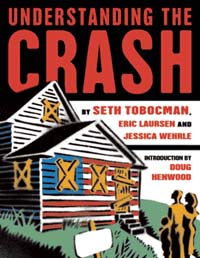 We in the Bay had the pleasure of hosting two events with Seth Tobocman last week. He doesn’t get all the way out west that often so it’s always a treat when he makes the voyage.
We in the Bay had the pleasure of hosting two events with Seth Tobocman last week. He doesn’t get all the way out west that often so it’s always a treat when he makes the voyage.
On Tuesday, June 29th, Seth and Eric Laursen were at Modern Times promoting their new book Understanding the Crash (AK Press doesn’t have any stock right now because the publisher is out, but you’ll be the first to know when we get copies). Eric and Seth gave an overview of how the crisis came about, how it is affecting communities across the country, and what some groups are doing to fight back.
| First up is a picture of Seth presenting artwork from his book You Don’t Have to Fuck People Over to Survive |
 |
| Next is Seth and Eric during the question and answer session. |
 |
| Then on Friday was Seth Tobocman and Eric Drooker at Station 40. If you were sitting all alone on Friday night pondering the meaning of life then you should add yourself to the events list at Station 40 and spice things up a bit (Station40events[at]lists.riseup.net). These two old friends, co-conspirators, and great performers aren’t under the same roof that often, so we have to thank the events committee at Station 40 for putting it all together. |
 |
| Seth showed pieces from Understanding the Crash and You Don’t Have to Fuck People Over to Survive. Keep up with more of Seth’s art and action here. Eric gave us a crash course in working with media moguls like the New Yorker (who often use his artwork), showed stories from Flood and Blood Song, showed some “concept art” for the animation he recently completed for the Howl movie, and narrated a pictorial tour of Palestine that he took not long ago. See more from Eric here. |
 |
| Thanks to everyone who came out. We’ll see you again soon. |
Posted on July 9th, 2010 in Happenings
Most readers of Revolution by the Book are probably familiar with the case of Oscar Grant. Well yesterday the BART cop who killed him, Johannes Mehserle, was convicted of involuntary manslaughter. It’s been a tense issue in the Bay for the last eighteen months and will certainly remain so. Much of downtown Oakland was boarded up all week while we waited to hear the verdict. Despite the pathetic coverage coming out of local news sources about “professional anarchists” coming to “pimp” local youth, people took to the streets tonight to have their say… though we may not have heard the last from Oakland’s youth.
For up-to-date news on the case and demonstrations, check out Indybay.
As the police worked to regain control of downtown and protesters melted back into the night I took the opportunity to walk the empty streets. By one a.m. you would have thought it was Christmas Eve in Oakland, except for the nature of the gifts left behind. Here’s a look at the aftermath of today’s demonstrations. No telling how much of it will be painted over and replaced by morning so here’s your own personal tour through the post-riot zone.
[p.s. dear readers it’s late and I added lighthearted captions, sorry if they take away from the severity of the actions]
| Oscar Grant mural |
 |
| . |
| We want to hear your story (as long as it doesn’t include violence) |
 |
| . |
| Riot for Oscar |
 |
| . |
| It was nice of the police to add targets |
 |
| . |
| Footlocker got looted |
 |
| . |
| Somebody decided to wear theirs right away |
 |
| . |
| Sears always seemed so impenetrable before |
 |
| . |
| Outdoor living |
 |
| . |
| Hayward police van |
 |
| . |
| Riot squad looking for sensible shoes |
 |
| . |
| Board meeting is canceled |
 |
| . |
| Banks get all the breaks |
 |
| . |
| Welcome to the future |
 |
| . |
| Direct and to the point |
 |
| . |
| Somebody has an awful sake hangover this morning |
 |
| . |
| Oops |
 |
| . |
| There’s a hole in Whole Foods! |
 |
| . |
| Fight usury |
 |
| . |
| Stay cool |
 |
| . |
| Sure to become a permanent fixture of the Community Bank of the Bay |
 |
| . |
| Black Bloc, Gold Fronts |
 |
| . |
| Somebody was after both |
 |
| . |
| The guy on the right wanted to know if he was going to be on youtube |
 |
| . |
| Down but not out |
 |
| . |
| Charred dumpster, possibly containing the remains of a hipster |
 |
| . |
| Someone didn’t see the sign |
 |
| . |
| Maybe they should have put signs facing all directions |
 |
| . |
| Paint bomb, what a mess |
 |
| . |
| Must be after hours |
 |
| . |
| Looting is hell |
 |
| . |
| It worked! |
 |
| . |
Done and Done
|
 |
| . |
| Solitude |
 |
Posted on July 8th, 2010 in AK Authors!, Happenings
 Okay, I’m lame. Jeff Conant launched his amazing book, A Poetics of Resistance: The Revolutionary Public Relations of the Zapatista Insurgency, last night at Modern Times Bookstore. And I forgot my camera. I’ve been working with Jeff for a few years as this book was birthed, but his talk at Modern Times took me back to Day One in terms of remembering why AK Press was so stoked about it from the get-go. You really need to read this book…and use it to make sense of how and why radical propaganda works (and sometimes doesn’t). Go here for an excerpt.
Okay, I’m lame. Jeff Conant launched his amazing book, A Poetics of Resistance: The Revolutionary Public Relations of the Zapatista Insurgency, last night at Modern Times Bookstore. And I forgot my camera. I’ve been working with Jeff for a few years as this book was birthed, but his talk at Modern Times took me back to Day One in terms of remembering why AK Press was so stoked about it from the get-go. You really need to read this book…and use it to make sense of how and why radical propaganda works (and sometimes doesn’t). Go here for an excerpt.
There was an afterparty at the lovely Casa Bonampak, a few blocks down the street (thanks Nancy!). About five beers and two tamales into that, I realized I had a crappy cell phone camera. So here is Jeff signing one of the many copies of his book that folks grabbed.
Posted on July 7th, 2010 in AK Book Excerpts
AK Press’s newest book, Sparking A Worldwide Energy Revolution: Social Struggles in the Transition to a Post-petrol World will arrive at the warehouse any second (and remember to take advantage of the 25% discount through the next month). In the midst of the global rage against BP and their catastrophic oil spill in the Gulf, it’s our distinct pleasure to present this exciting new collection. At 688 pages, it’s an ambitious book. The energy sector is changing dramatically and if we want to avoid being led by panics, peaks, and disasters, we’d better start investigating our options. Sparking provides no easy answers but it does map out the complex relationships between energy production and consumption, technology, and the capitalist relations that drive them. There’s nothing else like it. Read on for an excerpt from the Introduction, by Kolya Abramsky.
—–
 As the many chapters in this book show, a wide range of social struggles are emerging in relation to energy. An understanding of these struggles is important in order to assess both short-term priorities for collective action, as well as longer term strategic orientation within struggles that may take several years to bear fruit, if indeed they ever do. The book aims to pose strategic questions as to how to open up spaces that can bring about and mobilize the kind of mass social and political force that is necessary for an accelerated transition to a decentralized, equitable, and ecologically sensitive energy system, which contributes to a wider process of building emancipatory relations. In particular, an important aim of this book is to highlight the importance of ownership, labor, land, and livelihood in relation to a discussion of energy resources, their infrastructures, and technologies. The different chapters point to the fact that in order to get to the root of the problems, struggles in the North and South have to develop a collective global process to take decisions concerning energy.
As the many chapters in this book show, a wide range of social struggles are emerging in relation to energy. An understanding of these struggles is important in order to assess both short-term priorities for collective action, as well as longer term strategic orientation within struggles that may take several years to bear fruit, if indeed they ever do. The book aims to pose strategic questions as to how to open up spaces that can bring about and mobilize the kind of mass social and political force that is necessary for an accelerated transition to a decentralized, equitable, and ecologically sensitive energy system, which contributes to a wider process of building emancipatory relations. In particular, an important aim of this book is to highlight the importance of ownership, labor, land, and livelihood in relation to a discussion of energy resources, their infrastructures, and technologies. The different chapters point to the fact that in order to get to the root of the problems, struggles in the North and South have to develop a collective global process to take decisions concerning energy.
Above all, the aim of this book is to contribute to a process of ensuring that any future transition to a new energy system is part of a wider movement to construct non-capitalist relations that are substantially more egalitarian, decentralized, and participatory than the current relations. It strives to offer long-term perspectives in order to discern where axes of conflict and rupture lie, as well as where possibilities for common struggle in the short term might exist. In addition to the crucial question of which energy sources and technologies are the most suitable, there is also the question of how energy is used (or not used), in what quantities, and for what purposes.
If we make these decisions through capitalist markets, we end up stressed out, overworked, and murdered, divided and pitted against one another, while the planet goes to hell. If we make these decisions through the capitalist state, we end up repressed, silenced, and manipulated into believing that the sacrifices that are required of us to deal with this “emergency” and “crisis” are worth the suffering, since it will be the final crisis, and there will never be another “crisis” again, while in fact it will merely open up a new cycle of more of the same.
The book seeks to contribute to an appreciation of the open and political nature of the “energy crisis” and its “solutions,” and to question the idea of “transition” as something fixed and predetermined. While technology is, and will surely continue to be, of great importance, the process of building an emancipatory post-petrol energy system will not be the inevitable result of technological fate. If such a system is to emerge, it will largely be the result of collective human activity and choices, intentional or otherwise. There is no single “transition” process waiting to unfold that already exists in the abstract. Multiple possible transition processes exist, and the actual outcome will be determined through a long and uncertain struggle. These struggles are already rapidly taking shape, and in all probability we are only in the very early phases of this process. This book seeks to help orientate people within these emerging conflicts so that they can actively anticipate, prepare for, and sharpen these struggles.
Many different actors and voices play their part in the energy sector, and the sector is criss-crossed by multiple conflicts and alliances. This book seeks to create a space where different voices from around the world, who come from different areas the energy sector, can share information and listen to one another. In doing so, the aim is to contribute towards the building of a critical common analysis, or rather map, of the current worldwide “energy crisis.” It is hoped that this can help strengthen people’s ability to act collectively in order to intentionally shape future developments in the energy sector in ways that contribute to a rapid and smooth transition process, in the face of worldwide economic-financial and political crisis.
However, it is hoped that this book will go beyond information exchange and the development of common analyses. By bringing organizational processes that are frequently working in isolation into contact with one another, or at least making them known to each other, it is anticipated that the book may be able to contribute to concrete organizational processes, both in the short and longer term. As such, it is intended to be a networking tool that can contribute to building the kind of collective social force that is capable of bringing about an emancipatory “transition process.”
Rather than appealing to politicians and “official decision makers,” this book especially seeks to reach self-organized grassroots organizations with similar ideas and principles and from all continents, in order to contribute to the emancipatory potential of renewable energy within the context of wider social change. It is hoped that the book can make a significant contribution towards already existing networking processes between organizations, and the development of common communication tools to encourage increased exchange and knowledge of each other’s work, foster ongoing links and the creation of longer term collaborative initiatives. For this reason, to ensure it has a maximum impact possible, Sparking A Worldwide Energy Revolution is being published under a Creative Commons License. Translation into other languages is encouraged.
It is hoped that this collective work might contribute to strengthening people’s collective capacity for exchange and support between different struggles in defense of livelihoods, rights, and territories related to the global energy sector. This includes several aspects: on the one hand, rural communities throughout the world, including indigenous communities and communities of African descent, who are struggling against the negative impacts of extraction, processing and transportation of energy resources and the associated infrastructures. And on the other, workers in the existing energy sectors, as well as energy-intensive industries, and their communities and dependants who are struggling to protect their livelihoods in the face of the far-reaching structural changes that have begun and that are likely to intensify in the years ahead.
(more…)
Posted on July 5th, 2010 in AK Distribution
In celebration of Canada Day (July 1),* we’re proud to offer you these little beauties at 50% off for the entire month of July! Unrelated to that, but in the spirit of giving (and because they are our featured publisher this month), through July all books published by Haymarket Books are 25% off! God save the Queen!**
 Radical Priorities
Radical Priorities
By Noam Chomsky (edited by C.P. Otero)
In Radical Priorities, C.P. Otero sets out to “provide relatively easy access to Chomsky’s libertarian philosophy and political analysis.” Taken from a wide variety of sources, many never widely published—some never in a book at all—and spanning four decades, the reader is furnished with a truly comprehensive window into Chomsky’s anarchist convictions. Convictions which, while ever-present in his analysis are left largely misunderstood or worse Chomsky’s analysis, and the traditions that bore it, must not be left in obscurity. Now just $9.50!
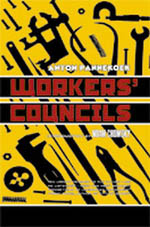 Workers’ Councils
Workers’ Councils
By Anton Pannekoek (edited by Robert Barsky)
Anton Pannekoek was the main theoretician of Left Communism. He lived and worked in workers’ councils from China to Germany over the first half of the century and militantly fought in working-class struggles all his life. He wrote Workers’ Councils while living under Nazi occupation in Holland. In this timeless text, Pannekoek provides his analysis of how we can create and sustain this practical model for social equality.
“Pannekoek’s book is a classic of radical thought. It should be read by all people who want to think beyond capitalism, beyond bureaucratic socialism, beyond opportunistic trade unionism, to the idea of direct democracy in the production and distribution of society’s enormous wealth.” —Howard Zinn
Now a mind-boggling $7.50! Get two!
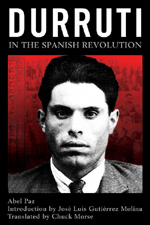 Durruti in the Spanish Revolution
Durruti in the Spanish Revolution
By Abel Paz
In this new and unabridged translation of the definitive biography of Spanish revolutionary and military strategist, Buenaventura Durruti, Abel Paz has given us much more than an account of a single man’s life. Durruti in the Spanish Revolution is as much the chronicle of an entire nation and of a tumultuous historical era. Paz seamlessly weaves intimate biographical details of Durruti’s life—his progression from factory worker and father to bank robber, political exile and, eventually, revolutionary leader—with extensive historical background, behind-the-scenes governmental intrigue, and blow-by-blow accounts of major battles and urban guerrilla warfare. Written with a thorough and sympathetic understanding of the anarchist ideals that motivated Durruti, this is an amazing and exhaustive study of an incredible man and his life-long fight against totalitarianism in both its capitalist and Stalinist forms. Now only $14.00!
 Born Under a Bad Sky:
Born Under a Bad Sky:
By Jeffrey St. Clair
Hold on tight as you open the pages of Born Under a Bad Sky and follow journalist Jeffrey St. Clair through a landscape of horrors and wonders, scenery all the more strange because the setting is our own bruised world, in our own fraught era. These urgent dispatches are from the front lines of the war on the Earth. Gird yourself for a visit to a glowing nuclear plant in the backwoods of North Carolina, to the heart of Cancer Alley where chemical companies hide their toxic enterprise behind the dark veil of Homeland Security, and to the world’s most contaminated place, the old H-bomb factory at Hanford, which is leaking radioactive poison into the mighty Columbia River. All is not lost: a new green resistance is taking root. The fate of the grizzly and the ancient forests of Oregon hinge on the courage of these green defenders. This book is also a salute to them. Now just $10.00!
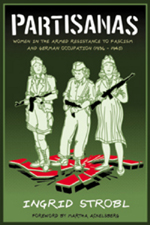 Partisanas:
Partisanas:
By Ingrid Strobl
Common stereotypes of women during wartime relegate them to the sidelines of history—to supporting roles like dutiful munitions factory workers or devoted wives waiting for their men to return home. The truth is that much of the armed resistance to fascism, before and during World War II, can be chalked up to women about whom official accounts have little or nothing to say. Through years of intrepid research and numerous interviews with the participants themselves, Ingrid Strobl excavates the history of the women who shouldered guns, planned assassinations, planted bombs, and were among the era’s most active antifascist fighters. Strobl’s commitment to and respect for her subjects has resulted in a work of both scholarly rigor and emotional depth. Weaving moving personal narratives into the broader history of the European resistance, Partisanas is both a detailed historical account and an investigation into what compelled women to reject their traditional roles to take up arms in a fight for a better world. Now just $11.00!
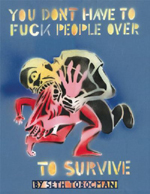 You Don’t Have to Fuck People Over to Survive
You Don’t Have to Fuck People Over to Survive
By Seth Tobocman (on tour now!)
You Don’t Have to Fuck People Over to Survive collects many of Tobocman’s most enduring images in a powerhouse assemblage that cuts right to the heart of 1980s activism. All the high (and low) points are there: the imprisonment of Mumia Abu-Jamal; the rise of Reaganomics; the struggle against apartheid; the Miami Race Riots; and, of course, the turf wars that dominated the city of New York, as activists and low-income families alike demanded their rights to the city’s abandoned buildings. Now just $10.00!
* Not really.
** I’m kidding. Gheez.
Posted on July 4th, 2010 in Happenings, Recommended Reading
A New Declaration of Independence
by Emma Goldman
[Published in Mother Earth, Vol. IV, no. 5, July 1909.]
When, in the course of human development, existing institutions prove inadequate to the needs of man, when they serve merely to enslave, rob, and oppress mankind, the people have the eternal right to rebel against, and overthrow, these institutions.
The mere fact that these forces–inimical to life, liberty, and the pursuit of happiness–are legalized by statute laws, sanctified by divine rights, and enforced by political power, in no way justifies their continued existence.
We hold these truths to be self-evident: that all human beings, irrespective of race, color, or sex, are born with the equal right to share at the table of life; that to secure this right, there must be established among men economic, social, and political freedom; we hold further that government exists but to maintain special privilege and property rights; that it coerces man into submission and therefore robs him of dignity, self-respect, and life.
The history of the American kings of capital and authority is the history of repeated crimes, injustice, oppression, outrage, and abuse, all aiming at the suppression of individual liberties and the exploitation of the people. A vast country, rich enough to supply all her children with all possible comforts, and insure well-being to all, is in the hands of a few, while the nameless millions are at the mercy of ruthless wealth gatherers, unscrupulous lawmakers, and corrupt politicians. Sturdy sons of America are forced to tramp the country in a fruitless search for bread, and many of her daughters are driven into the street, while thousands of tender children are daily sacrificed on the altar of Mammon. The reign of these kings is holding mankind in slavery, perpetuating poverty and disease, maintaining crime and corruption; it is fettering the spirit of liberty, throttling the voice of justice, and degrading and oppressing humanity. It is engaged in continual war and slaughter, devastating the country and destroying the best and finest qualities of man; it nurtures superstition and ignorance, sows prejudice and strife, and turns the human family into a camp of Ishmaelites.
We, therefore, the liberty-loving men and women, realizing the great injustice and brutality of this state of affairs, earnestly and boldly do hereby declare, That each and every individual is and ought to be free to own himself and to enjoy the full fruit of his labor; that man is absolved from all allegiance to the kings of authority and capital; that he has, by the very fact of his being, free access to the land and all means of production, and entire liberty of disposing of the fruits of his efforts; that each and every individual has the unquestionable and unabridgeable right of free and voluntary association with other equally sovereign individuals for economic, political, social, and all other purposes, and that to achieve this end man must emancipate himself from the sacredness of property, the respect for man-made law, the fear of the Church, the cowardice of public opinion, the stupid arrogance of national, racial, religious, and sex superiority, and from the narrow puritanical conception of human life. And for the support of this Declaration, and with a firm reliance on the harmonious blending of man’s social and individual tendencies, the lovers of liberty joyfully consecrate their uncompromising devotion, their energy and intelligence, their solidarity and their lives.
This `Declaration’ was written at the request of a certain newspaper, which subsequently refused to publish it, though the article was already in composition.
 This is an Honour Song: Twenty Years Since the Blockades
This is an Honour Song: Twenty Years Since the Blockades Revolution and Other Writings: A Political Reader Gustav Landauer
Revolution and Other Writings: A Political Reader Gustav Landauer Raider Nation, Volume 1: From the January Rebellions to Lovelle Mixon and Beyond
Raider Nation, Volume 1: From the January Rebellions to Lovelle Mixon and Beyond Hopes and Prospects
Hopes and Prospects




 So, for the first installment of Back Issues, I’ve decided to highlight two publications archived at the
So, for the first installment of Back Issues, I’ve decided to highlight two publications archived at the  They both were important to me as a young critter in the 1970s and 1980s, for the fact that they addressed new and emergent concerns on the left about which the old-school stuff I was reading often had little to say, and for their frequent focus on culture (art, music, poetry, comics…even popular culture), which made “politics” a lot more interesting.
They both were important to me as a young critter in the 1970s and 1980s, for the fact that they addressed new and emergent concerns on the left about which the old-school stuff I was reading often had little to say, and for their frequent focus on culture (art, music, poetry, comics…even popular culture), which made “politics” a lot more interesting. In mid-1968, Paul Buhle started to take the magazine in a different direction, emphasizing special themes and farming out some issues to groups of radically minded thinkers in other cities. (It was still produced in Madison, and a shifting group of local people helped with the production.). The first issue to mark the new trend was
In mid-1968, Paul Buhle started to take the magazine in a different direction, emphasizing special themes and farming out some issues to groups of radically minded thinkers in other cities. (It was still produced in Madison, and a shifting group of local people helped with the production.). The first issue to mark the new trend was  Sleep-deprived Macio here with a lovely reportback on Detroit’s 12th annual Allied Media Conference. In case you are sleeping on this empowering collaboration of media, technology and communication in the name of social justice allow me to break down the essentials.
Sleep-deprived Macio here with a lovely reportback on Detroit’s 12th annual Allied Media Conference. In case you are sleeping on this empowering collaboration of media, technology and communication in the name of social justice allow me to break down the essentials. Aside from these amazing workshops, AMC organizers implement fun social events for attendees. Some of these include karaoke while bowling, and various musical events with artists like Climbing Poetree, Defiance Ohio, and Tamar-Kali. The Detroit community really opens its arms to this AMC. Local eateries provide discounts, Cass Café hosted an all-night dance party and local community members were in high attendance.
Aside from these amazing workshops, AMC organizers implement fun social events for attendees. Some of these include karaoke while bowling, and various musical events with artists like Climbing Poetree, Defiance Ohio, and Tamar-Kali. The Detroit community really opens its arms to this AMC. Local eateries provide discounts, Cass Café hosted an all-night dance party and local community members were in high attendance. The AK Press table was stocked with great titles AK and Distro alike! We had new stuff like
The AK Press table was stocked with great titles AK and Distro alike! We had new stuff like  We in the Bay had the pleasure of hosting two events with Seth Tobocman last week. He doesn’t get all the way out west that often so it’s always a treat when he makes the voyage.
We in the Bay had the pleasure of hosting two events with Seth Tobocman last week. He doesn’t get all the way out west that often so it’s always a treat when he makes the voyage.





































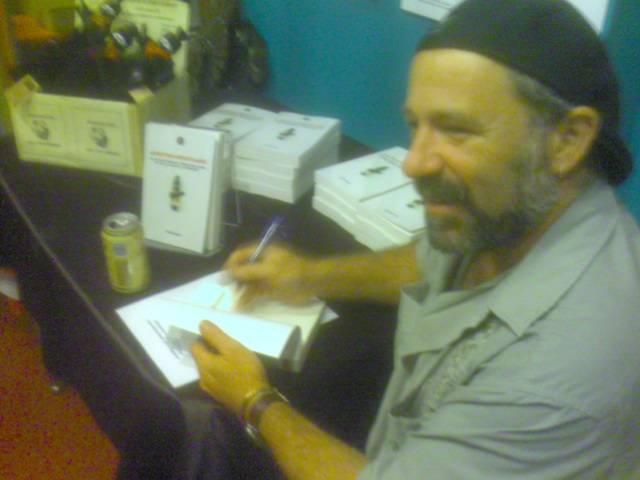

 Radical Priorities
Radical Priorities Workers’ Councils
Workers’ Councils Durruti in the Spanish Revolution
Durruti in the Spanish Revolution Born Under a Bad Sky:
Born Under a Bad Sky:  Partisanas:
Partisanas:  You Don’t Have to Fuck People Over to Survive
You Don’t Have to Fuck People Over to Survive